Pediatric
Encouraging Crawling: Tips for a Strong Start
March 28, 2024Once your baby starts showing interest in being mobile you might be tempted to rush them through the crawling stage and start to encourage them to get up and moving on their feet, but our physical therapists recommend not rushing this important milestone and instead encouraging the crawling stage as it provides your kiddo with so many benefits you may not have considered.
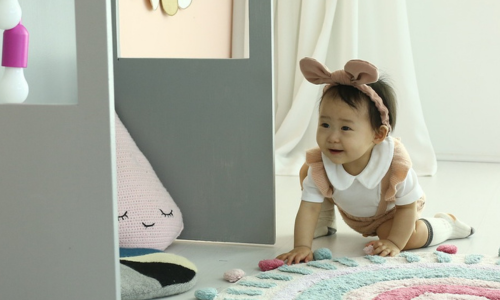
Walking takes strength, why does my baby need to crawl before they walk to develop their strength?
It’s true that learning to walk will require your baby to build their leg strength, but what about all the arm strengthening they’re missing out on by not crawling first? Crawling is not only the first time your baby puts significant weight on their hands, wrists, arms, and shoulders, but also the longest amount of time they’ll spend developing these muscles. Muscles that will later be used to feed themselves, play with toys, color, and dress themselves. The muscles in their legs and core will also strengthen during this time, which will make transitioning to walking even easier.
You need postural control to walk, why can’t my baby learn both at the same time?
While your baby could learn postural control while they tackle the task of learning to walk, crawling will provide them with more stability and practice while they gain the postural control skills required to walk properly. Crawling requires your baby to engage their core muscles to support their body weight which is essential for maintaining an upright posture when standing and walking.
Since my baby has great hand-eye coordination when sitting and playing with toys, why do they need to crawl before they walk?
Good hand-eye coordination is an important skill for babies to learn, but coordination of their limbs is necessary for crawling, walking, and more advanced movements. Crawling encourages babies to learn how to simultaneously move their arms and legs in a coordinated manner, which helps control their balance, which in turn improves their ability to maintain appropriate posture when they eventually begin to walk.
My baby recognizes themselves in the mirror and engages appropriately with their play mats and stacking toys, what more awareness and motor planning do they need to walk?
Crawling helps babies establish their body awareness within space safely, so that they can learn how to maneuver around their environment with minimal risk. It helps to teach them an understanding of their own movement, and helps enhance their depth perception, so that when they begin walking, they will be less likely to trip, fall, or run into things.
My baby gathers information about their surroundings whether they’re in a highchair, on a playmat, or in my arms, doesn’t that make them ready to walk?
Some of the most important information gathering and processing skills that your baby gains through crawling are done by sensory exploration and multisensory integration. Crawling allows babies to explore their environment through touch, sight, and sound. While they touch different surfaces and textures, they are learning to integrate this sensory information with their motor planning to adapt to various terrains and surfaces as they grow.
Tips for Encouraging Crawling
- Practice tummy time early and often.
- Use play mats and play gyms.
- Create a safe and open space for exploration.
- Babyproof their environment.
- Focus on floor-based activities.
- Invest in crawl through tunnels.
- Avoid walkers and exersaucers.
- Offer motivating toys.
- Provide interaction and praise.
- Be patient.
Author’s Note:
The valuable insights and information shared in this article were provided by the Schreiber Center for Pediatric Development’s pediatric physical therapist Rachel D’Arcy. Rachel’s extensive knowledge and experience in pediatric physical therapy was instrumental in crafting the content of this piece.
As a nationally recognized pediatric facility, the Schreiber Center for Pediatric Development provides family-centered education and therapy programs for infants, children and adolescents with disabilities, developmental delays, and acquired injuries. Our goal-oriented approach maximizes each child’s ability to function independently within the community.
General Monthly eNewsletter Sign Up
Sign up to receive monthly newsletters to your email box to learn more about what is going on at the Schreiber Center, and how you can help support our mission to help every child in need reach their fullest potential.
VitalStim Therapy for Dysphasia Now Offered at the Schreiber Center
February 15, 2024We’re delighted to announce that with the addition of Ashley Shaffer to our speech-language department we are now able to offer VitalStim therapy for kids with swallowing disorders. Ashley is the first of our speech-language pathologists to become certified in this revolutionary non-invasive therapy that uses electrical currents to stimulate the throat muscles for proper and safe swallowing. As the only FDA approved device for the treatment of dysphagia, or difficulty swallowing, we are thrilled to add this treatment option to our arsenal.
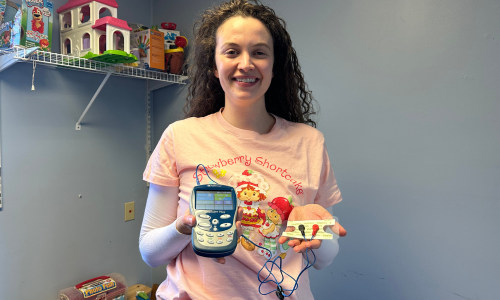
Of course, even with a speech-language pathologist who was certified in this therapy technique, without the necessary equipment we would not be able to offer this life-changing therapy to our Schreiber kids. Thankfully in October of 2023, we received $13,050 from the GIANT Company through their Make a Difference Challenge, which has allowed us to purchase the VitalStim Plus Electrotherapy and SEMG Biofeedback System and VitalStim Electrodes. With access to this state-of-the-art equipment, we no longer have to turn children who need this specialized therapy service away or refer them to other healthcare providers to receive the care they need.

The most common difficulties related to feeding seen at Schreiber are children with difficulties related to the oral stage of swallowing. But now that we offer VitalStim therapy at the Schreiber Center as an option to clients struggling in the pharyngeal phase of swallowing, we expect to be able to serve even more children with feeding challenges.
Many of us consider swallowing to be an automatic reflex but medically it’s a complex action involving roughly 50 pairs of muscles and nerves that require coordination in a 3-stage process to move food or liquid from the mouth to the stomach. The first of these three stages is the oral phase which includes gathering food in the mouth and chewing. Dysphasia in this phase may cause difficulty chewing or manipulating the food in the mouth. Traditional feeding therapies are most effective with oral phase dysphasia.
The second stage is the pharyngeal phase which is the first stage of swallowing where the food begins to move from the mouth through the pharynx, during which time the airway must be protected to avoid food or liquid entering the airway. Dysphasia in this phase involves difficulty coordinating these muscle movements leading to difficulties in clearing the airway and moving the food to the esophagus. This is the phase where VitalStim therapy for dysphasia is most helpful, as it improves the coordination and strength of the muscles involved in this phase.
The third stage of moving food or liquid from the mouth to the stomach is called the esophageal phase and is the final phase where the food is transported through the esophagus and into the stomach. Dysphagia in this phase can be caused by a narrowing in the esophagus or poor muscle coordination in the esophagus. Dysphasia in this phase often requires dilation procedures, medication or in some cases surgical intervention.
There are several reasons why a child might need feeding therapy including: children with neuromuscular disorders who experience weakness of the throat muscles, children with congenital conditions such as cleft palates, children with developmental delays that may affect their ability or willingness to swallow various textures or liquids, and of course children who have undergone surgery or have experienced an injury which effects the muscles involved in swallowing. In each of these situations the children who need it will now be able to benefit from the use of VitalStim therapy in their sessions. This marks a significant leap forward in our mission to provide the best possible care for every child that enters our doors.
Author’s Note:
The valuable insights and information shared in this article were provided by the Schreiber Center for Pediatric Development’s pediatric speech-language pathologist Ashley Shaffer. Her extensive knowledge and experience has been essential in shaping the content of this piece.
Contribute to the Kids’ Care Fund now to ensure that children in need, both present and future, receive these essential services regardless of their family’s financial situation.
As a nationally recognized pediatric facility, the Schreiber Center for Pediatric Development provides family-centered education and therapy programs for infants, children and adolescents with disabilities, developmental delays, and acquired injuries. Our goal-oriented approach maximizes each child’s ability to function independently within the community.
The Myth and Reality of In-Toeing and Out-Toeing
February 1, 2024Have you ever found yourself marveling at your little one’s unique walking style? Those adorable little toes of theirs pointing inward or outward might seem like a quirky phase they’ll grow out of, but that’s a common misconception. Let’s dive into the myth and reality of in-toeing and out-toeing in kids and why pediatric physical therapy might be just what the doctor ordered.
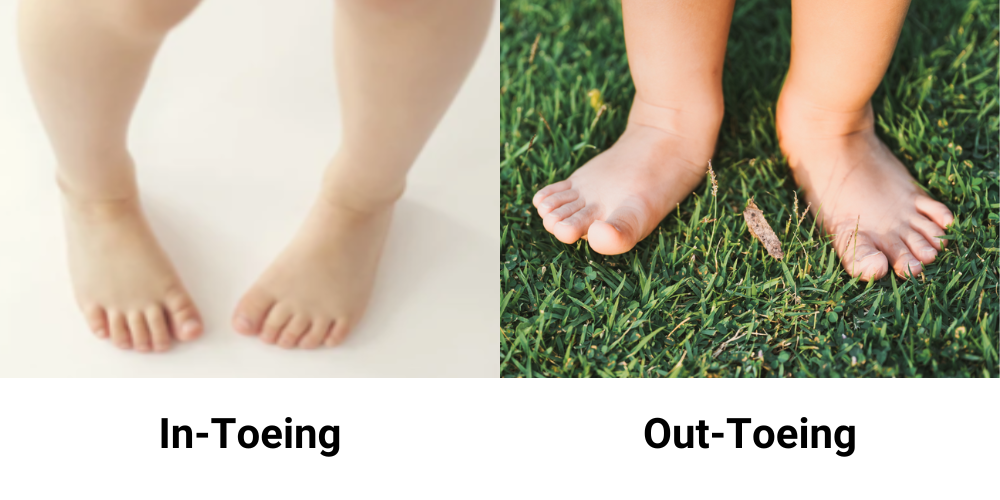
When little ones initially start walking, it is common to see some bowing (bending outwards) at the knees, while maintaining knee and foot alignment. At two years-old, we expect our tiny tots to conquer walking, stairs, and climbing with their feet pointing forward. By three years-old, those little piggies should ideally be in line, meaning their feet should be in line with their knees and tibias. But what happens when the journey takes a zigzag detour?
The easiest way to tell if your child is in-toeing or out-toeing is to watch their feet while they walk. If their feet are not facing forward in a straight line, they may need professional intervention. Another way to determine if they may be exhibiting signs of this is if their legs look like they’re making the letter W while they’re sitting and playing on the floor, or if they’re falling over or losing their balance more often than what seems normal for their age. In all these cases you should ask your pediatrician or primary care provider to make a referral to have their stance and gait reviewed by a pediatric physical therapist to determine if they would benefit from ongoing physical therapist at the Schreiber Center for Pediatric Development to retrain their gait and posture.
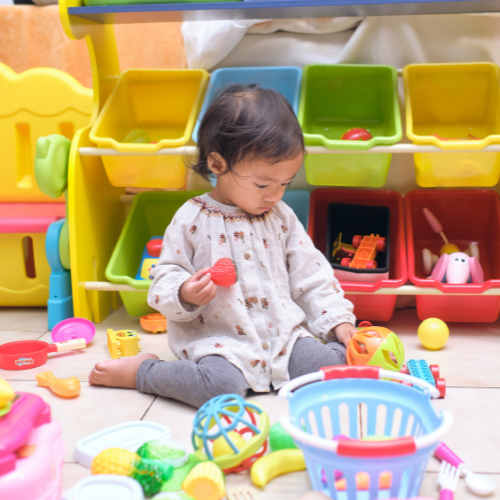
Ignoring in- and out-toeing can lead to several more serious complications. These rotational deviations can cause muscle imbalances, gait inefficiencies, and even osteoarthritis of the knee. While muscle imbalances and gait inefficiencies can be worked on and improved in physical therapy as your child ages, once osteoarthritis of the knee begins, there is no way to reverse it, which is why pediatric physical therapy for in- and out-toeing is so important. Another common issue seen with in-toeing and out-toeing is foot overpronation, which can cause the arches of their tiny feet to flatten more than they normally would, which increases their risk of foot and leg injury. It is critical to address any rotational issues as soon as possible because as children age, it is hard to make changes to their bony structure.

There are another several reasons behind why a child might walk in a in-toe or out-toe style including: w-sitting habits, ligament laxity, pelvic instability, low muscle tone, poor trunk control or femoral rotation, and the solution to them all is pediatric physical therapy. By working with a pediatric physical therapist at the Schreiber Center, kids can work on targeted exercise to strengthen the muscles in the affected areas and learn how to use these strengthened muscles to stand and walk with correct posture promoting neutral alignment. They may also be fitted for orthotics or Togrite Strapping to support their feet and promote proper alignment while they attend physical therapy sessions to improve their balance, coordination, and flexibility.
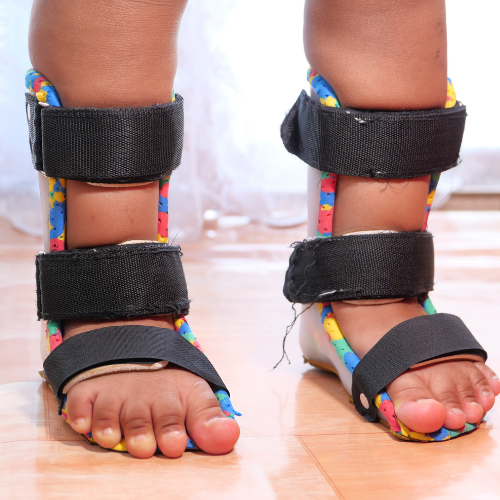
The most important and impactful aspect though, is making sure that in- and out-toeing is caught early, and addressed through pediatric physical therapy as soon as possible. By addressing these concerns as soon as you notice them, you are providing your child with a greater chance to develop healthy posture and gait and minimize the risks of long-term complications associated with in- and out-toeing.
Author’s Note:
The valuable insights and information shared in this article were provided by the Schreiber Center for Pediatric Development’s pediatric physical therapist Rachel D’Arcy. Rachel has a wealth of experience in pediatric physical therapy, and her expertise has been instrumental in crafting the content of this piece.
If you are interested in learning more about how Schreiber’s Pediatric Physical Therapy Services can help your child visit https://www.schreiberpediatric.org/physical-therapy/
As a nationally recognized pediatric facility, the Schreiber Center for Pediatric Development provides family-centered education and therapy programs for infants, children and adolescents with disabilities, developmental delays, and acquired injuries. Our goal-oriented approach maximizes each child’s ability to function independently within the community.
How Schreiber Transformed Our Son’s Feeding Challenges: A Personal Testimonial
January 30, 2024Written by: Schreiber Client Finn’s Mom, Danielle Gwilt
Our son Finn was diagnosed with food allergies shortly after his first birthday, and a chronic digestive condition called Eosinophilic Esophagitis (EoE) about a year after that. Due to allergies and discomfort due to EoE, feeding Finn was a challenge pretty quickly after he began solid foods. He was incredibly reluctant to try or even touch new foods or drinks. Finn started occupational therapy, prior to coming to Schreiber, at 18 months for these feeding aversions and sensory issues. While this initial round of OT helped us to learn about Finn’s sensory needs, we made no progress at all with his eating and decided to stop the therapy. We were then referred to a speech therapist outside of the Schreiber Center to see if they could help. After about a year of visits with them, while Finn had made minor progress, they felt we didn’t have anything new to try and we were discharged from their care.
During a visit with his nutritionist around Finn’s third birthday we were discussing his ongoing feeding issues and she recommended that we reach out to the Schreiber Center for Pediatric Development. She recommended we try to see Sarah Terry specifically if she was available, as she had heard Sarah was especially good with strong-willed, picky eaters. We quickly realized how right she was! A few months after Finn turned 3 we had our evaluation and acceptance into Schreiber’s OT program, and were lucky enough to get a slot in Sarah’s schedule.
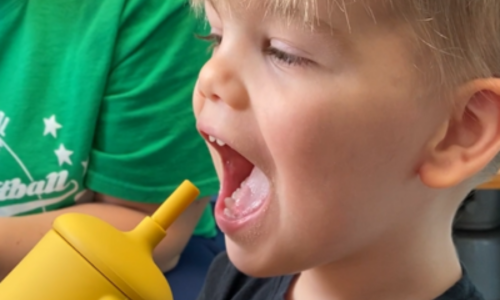
At the time of our admission, Finn (3 years old) was drinking from a bottle only, would only drink oat milk, and refused every type of cup offered. He was only eating 8-10 foods with regularity. He was also still eating baby food purees every day as one of his main foods. Our initial goals with Schreiber were to get Finn to try new foods, add new foods into his diet as regularly accepted foods, and to drink out of anything other than a bottle.
Initially, Finn was very reluctant to attending therapy, likely because he had been through other programs. What Schreiber offers is so different from anywhere else we had been. Schreiber allows for kids to make their own choices (toys they want to play with, a certain apparatus they may want to try, etc.) while still working toward the child’s goals and setting clear boundaries. Finn quickly warmed up to Schreiber and to Sarah due to the fun atmosphere and the incredible patience and understanding she showed while working with us. Sarah employed a wide array of play-based OT to entice Finn to try new foods. He was able to get the needed sensory input to his body by jumping and climbing in the large OT room before moving to a smaller room for therapy. Sarah would spend time playing with toys, games, painting, etc. in exchange for Finn touching, playing with, and eventually tasting the new foods.

Sarah took the time to get to know Finn and his interests and form a true relationship with him. She made his appointments fun and silly, all while working towards his goals. She was never visibly frustrated with him, even through some incredibly frustrating visits where he would flat-out refuse to cooperate. And she celebrated each win with us – no matter how small. Her positive and good-natured attitude made returning each week a pleasure, rather than the chore that therapy can often feel like. Sarah gave us suggestions on foods to try, ways to make slight alterations to foods to get him to accept new things, and a ton of tools to use at home as well.
We’d be remiss if we didn’t also mention Lisa at the front desk! She always welcomed our family with a smile and would greet Finn by name within just a few short weeks of his attending Schreiber. She truly assists in making Schreiber feel welcoming from the time you walk in the front door.
The progress Finn made through our time at Schreiber is truly remarkable. His willingness to try new foods, and to try foods more than once, has grown exponentially. He has a much larger catalog of widely accepted foods he’ll eat on a routine basis. He no longer drinks out of a bottle and will drink more than just one type of drink.

There are no words to express how much Schreiber positively impacted our lives. We are forever grateful to Sarah and the team at Schreiber for all they did for us and would highly recommend them to anyone whose child needs assistance!
Help Schreiber Clients like Finn receive the care they need, consider donating in support of our Kids’ Care Fund, a long and short term savings account used to cover the costs of uncompensated care.
As a nationally recognized pediatric facility, the Schreiber Center for Pediatric Development provides family-centered education and therapy programs for infants, children and adolescents with disabilities, developmental delays, and acquired injuries. Our goal-oriented approach maximizes each child’s ability to function independently within the community.
OASUS Harness System Takes Pediatric Physical Therapy to New Heights at Schreiber Center
January 18, 2024The new physical therapy gym at the Schreiber Center for Pediatric Development is now open! This state-of-the-art facility is equipped with a range of innovative equipment and open spaces, all meticulously designed to enhance therapy sessions for all our PT patients. This environment allows for more personalized therapy in a warm and inviting atmosphere, filled with natural light, vibrant colors, and a sense of fun. It is particularly welcoming to our young patients, putting them at ease, making them more receptive to therapy, and eager to engage in their rehabilitation.
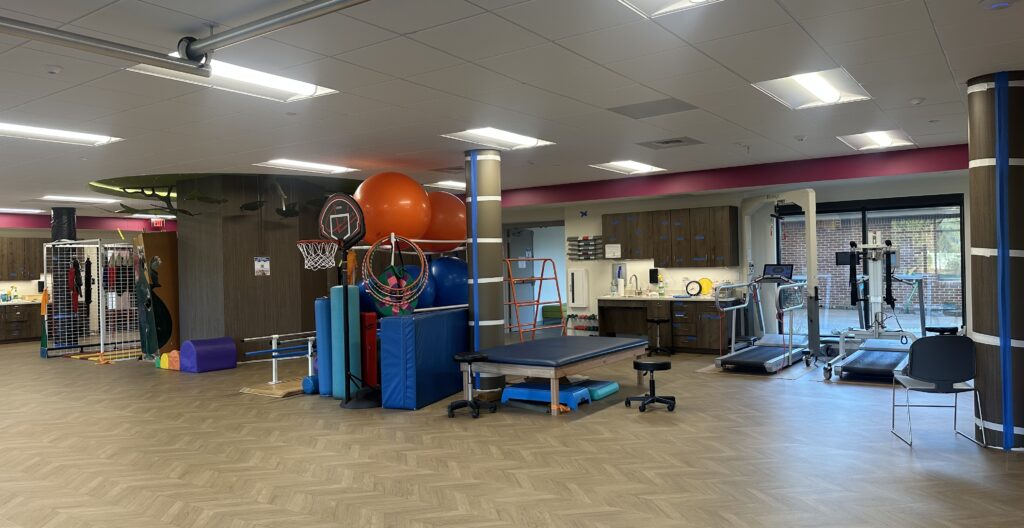
One of the most exciting features of our new gym is the introduction of the OASUS Harness System, a cutting-edge bodyweight support system that takes pediatric physical therapy to the next level. Provided by Enliten LLC, this system offers a flexible and dynamic approach to gait training, enabling our young patients to experience a greater range of motion, including rotational and frontal plane movement. This added versatility is crucial in helping our children develop their motor skills, balance, and coordination. The OASUS system also incorporates bungee cords, encouraging active engagement and fostering independence, thus strengthening their muscles and overall physical development. Furthermore, it simplifies therapists’ work on important milestones like stair climbing.

Our new rock wall adds a fun and challenging element to physical therapy sessions for many of our clients. Climbing the rock wall helps children build strength, coordination, and self-confidence while enjoying the process. Combining engaging activities with therapeutic methods is just one way our physical therapists help children reach goals others didn’t believe possible. We’ve expanded our gym to include new exercise equipment, including stationary bikes, to further this goal.
Safety is a top priority at Schreiber, and we’ve updated our mat tables to provide a comfortable and safe surface for various therapeutic exercises and activities in the new gym. These tables offer enhanced support for our children during stretching and strengthening routines, creating a more conducive environment for their rehabilitation.
“The new gym has provided us with more space and flexibility for personalized therapy. It is very inviting and bright and fun. The several new additions including the OASUS, rock wall, and new mat tables allow us to have even more treatment options to provide the best therapy to the kids that we serve.”
– Laurie Panther, Physical Therapist at the Schreiber Center.
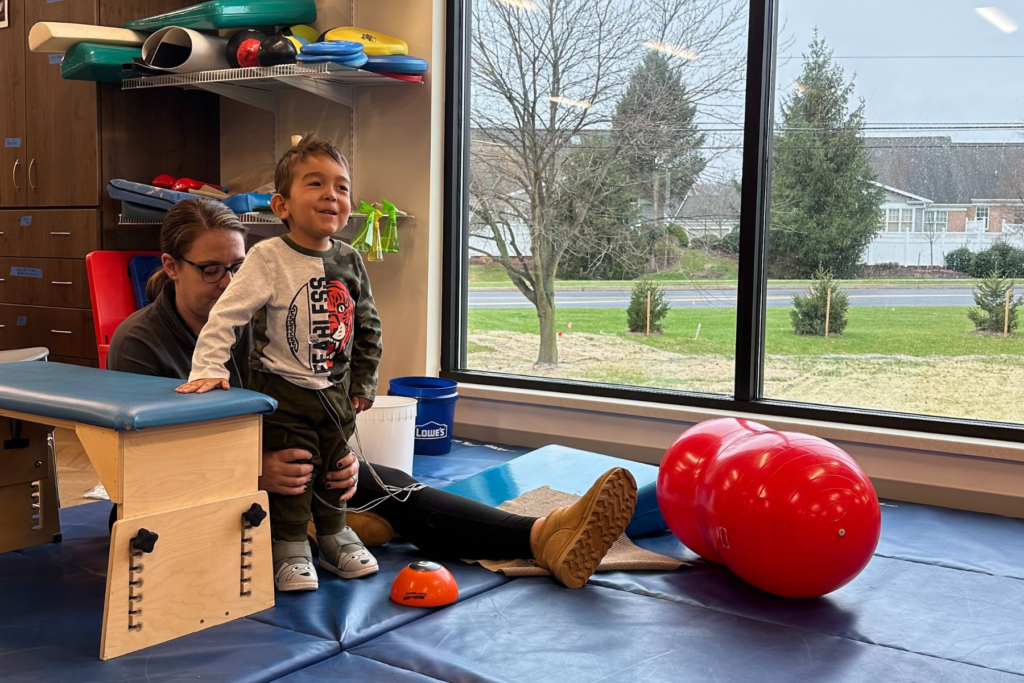
Have you ever seen a tree in the middle of a PT gym? If you’ve had sessions in ours, you have. And soon, we’ll be introducing sensory boards and other vertical play areas to enhance our therapy sessions even further on this tree. These additions will provide opportunities for sensory integration and cognitive development. Just another example of how we’re making therapy not only effective but also enjoyable for our young patients.
While the main gym is complete and open to clients, we are still working on completing extra treatment rooms dedicated to casting and pelvic floor treatments, greatly enhancing the level of care we can offer. These specialized rooms will ensure that our children receive the individualized attention they deserve, with access to the specific therapies they require.
The new physical therapy gym at the Schreiber Center stands as a testament to our commitment to the children and families we serve. We are deeply grateful to our supporters, donors, and partners who have made this space possible. Stay tuned for updates as we continue our renovations throughout the center to bring our clients the most innovative and up-to-date technology and services available. The future is bright at the Schreiber Center, and we can’t wait to share it with you!
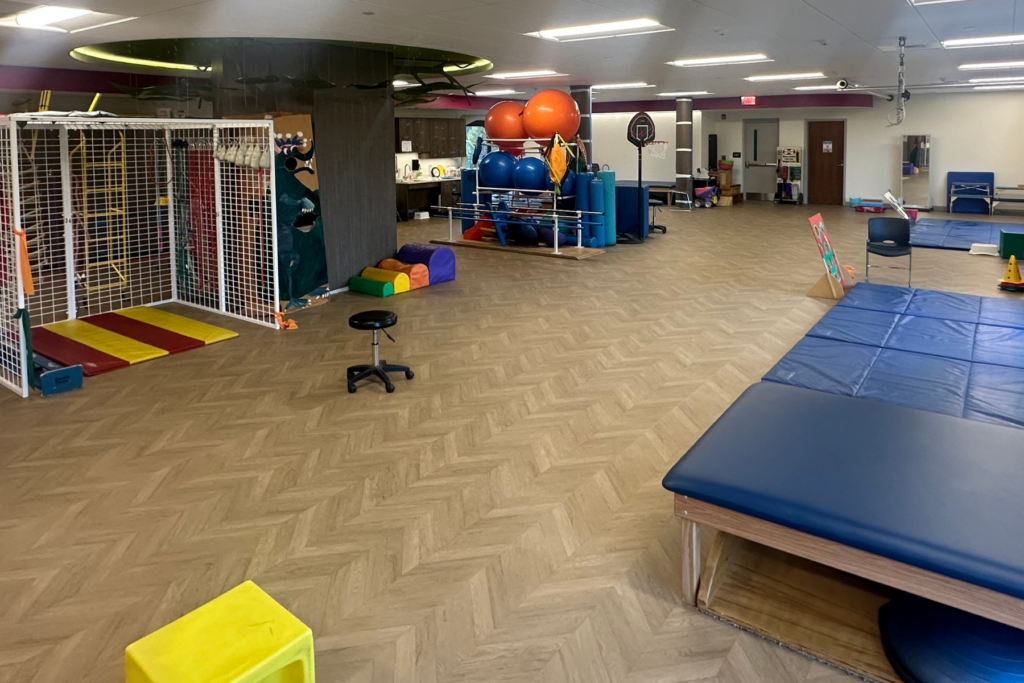
Donate today to help us continue to update and improve our spaces so that we can provide quality care to more children in need.
As a nationally recognized pediatric facility, the Schreiber Center for Pediatric Development provides family-centered education and therapy programs for infants, children and adolescents with disabilities, developmental delays, and acquired injuries. Our goal-oriented approach maximizes each child’s ability to function independently within the community.
Small Victories Creating Big Impacts for the Morales Family
January 8, 2024Teresa, the youngest, and fifth of the Morales children to receive pediatric therapy services here at the Schreiber Center faced hurdles with her speech and fine motor skills. Her parents, already familiar with the impact of our services, turned to Schreiber again, in the hopes that we could help Teresa savor the simple joys of childhood and build the tools necessary to succeed in adulthood.

Early life for Teresa felt like a puzzle missing crucial pieces. Her toys requiring nimble fingers laid untouched, and words escaped her, leaving her frustrated and easily overwhelmed. Family outings felt more like survival missions than moments to cherish.
Following Early Intervention services, Evelyn brought Teresa to Schreiber where she embarked on a journey to unravel her potential. With each session, her therapists Maddy, Camilla, and later Sarah weren’t just guiding her through exercises, but rather sculpting experiences tailored to Teresa’s interests. Sensory integration was a cornerstone to her sessions, weaving therapy tasks with activities specifically designed to help balance her sensory needs and help her focus on her therapy tasks. It was in these moments that she found the balance she needed to thrive.
Now, Sarah and Maddy skillfully maintain Teresa’s focus during therapy by introducing captivating games and activities tailored to her interests. By aligning tasks with her current preferences, they’ve witnessed incredible strides. Teresa’s artistic abilities have flourished, delighting her mother, who proudly exclaims, “She can draw a person now!” This achievement stands as a monumental step for Teresa, considering her past aversion to crayons due to sensory issues.
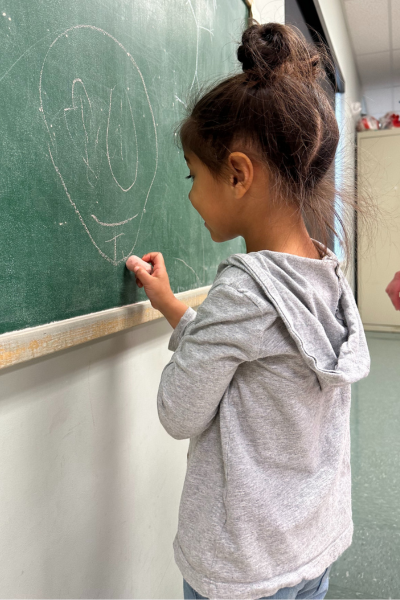
Her therapists have each provided the family with strategies to support her progress at home. As a result, the entire household now actively engages in sensory activities and verbal interactions. Evelyn shares that “I’m overstimulated” has become a familiar phrase in their home which serves as a unique tool for the family, helping them not only acknowledge their individual thresholds but also establish personal boundaries within the household.
Aside from engaging in sensory exercises at home, the family actively aids Teresa’s language development. Through guidance from Maddy, they’ve discovered that avoiding direct questions like “What color is this?” in favor of options like “Would you like to color this blue?” and allowing Teresa to express her choice by finding the specific color she prefers is a more effective learning approach for her.
Gaining confidence in her language abilities has empowered Teresa to voice her desires and needs effectively. Her newfound skills in self-advocacy have transformed her life. Now attending a mainstream preschool, she joyfully engages with friends, relishing playtime in the make-believe kitchen. Teresa has evolved from merely trailing her friends and staying silent to being an active participant, engaging in reciprocal play and conversation. She’s even developed a fondness for family outings and group activities, enhancing not only her own experience but the collective enjoyment of her entire family.

Evelyn, having navigated the therapeutic journey with five of her children at the Schreiber Center, imparts a valuable lesson for families walking a similar path. Her wisdom encapsulates the essence of patience and cherishing the seemingly small victories. In her words, “Be patient. Appreciate the small things. Sometimes parents get too caught up in the big milestones and forget to celebrate the small improvements. It’s those small things that are a big deal and celebrating them helps keep your child motivated to keep working towards reaching the big goals.”
Help Schreiber Clients like Teresa receive the care they need, consider donating in support of our Kids’ Care Fund, a long and short term savings account used to cover the costs of uncompensated care.
As a nationally recognized pediatric facility, the Schreiber Center for Pediatric Development provides family-centered education and therapy programs for infants, children and adolescents with disabilities, developmental delays, and acquired injuries. Our goal-oriented approach maximizes each child’s ability to function independently within the community.
Thank You to our 2023 Ambassadors!
December 31, 2023As we reflect on 2023, we are filled with gratitude for the amazing kids and families who have allowed us to spotlight their journeys through our therapy services, the true champions of our mission – our 2023 Schreiber Ambassadors!

It is through your tireless efforts that you’ve helped spread awareness about the vital work we do at Schreiber. Your advocacy has not only shone a spotlight on the challenges faced by those we serve but has also illuminated the pathways to hope and healing that our organization provides.
Your participation in our fundraising initiatives has been nothing short of extraordinary. By leveraging your networks and utilizing your influential voices, you’ve helped reach and exceed our goals all year so that we can continue making a meaningful difference in the lives of all #SchreiberKids. Your commitment to the betterment of our community is not only commendable, but also deeply appreciated.
As we express our gratitude, we also want to acknowledge the impact you’ve had on fostering a sense of community and belonging within the Schreiber family. Your enthusiasm has resonated with others, creating a ripple effect that strengthens the bonds of support and solidarity among those who share a connection to our organization.
In recognition of your exceptional contributions, we want to express our deepest appreciation. Your willingness to be ambassadors for Schreiber has not only elevated our mission but has also touched the hearts of those who have had the privilege of hearing your stories.
Thank you, 2023 Schreiber Ambassadors, for everything you’ve done to support our mission this year!
Support the therapy and education of our current and future Schreiber kids by donating to our Kids’ Care Fund today!
As a nationally recognized pediatric facility, the Schreiber Center for Pediatric Development provides family-centered education and therapy programs for infants, children and adolescents with disabilities, developmental delays, and acquired injuries. Our goal-oriented approach maximizes each child’s ability to function independently within the community.
Navigating New Year’s Eve with Kids on the Autism Spectrum: A Guide to Sensory-Friendly Celebrations
December 21, 2023New Year’s Eve, a night of joy and anticipation for many, can pose unique challenges for families with kids on the autism spectrum or those with sensory processing disorders (SPD). However, with thoughtful planning and a touch of creativity, you can ensure a more comfortable and enjoyable celebration for your child. Our therapists have shared valuable insights and suggestions to help you navigate New Year’s Eve with your child on the autism spectrum or with SPD.
Celebrate at Noon or with a Different Time Zone

Consider breaking from tradition and celebrating the arrival of the New Year at noon instead of midnight. This alternative allows your child to partake in the festivities without disrupting their bedtime routine. If noon feels too early, consider celebrating with a European country’s time zone (e.g., 7 PM ET for London or 8 PM ET for Paris), allowing your child to enjoy the excitement while still maintaining a reasonable bedtime.
Explain New Year’s Eve & What They Can Expect
Take the time to explain the global celebration of New Year’s Eve and any specific traditions your family follows. Address the possibility of fireworks in the neighborhood by describing the sounds and emphasizing their safety. Watching fireworks videos on platforms like YouTube can familiarize your child with the visual and auditory experience. Consider skipping loud noise makers and opt for quieter more familiar toys if your child enjoys making noise.
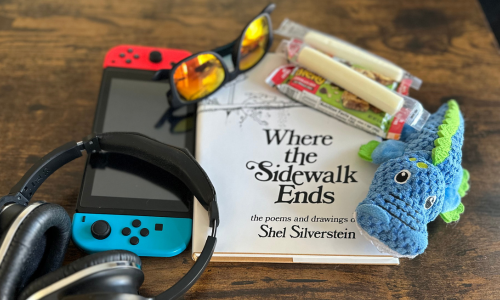
If you plan to go out, discuss the event with your child and establish a “safe space” or escape plan. Prepare a sensory-friendly kit with items such as sunglasses, headphones, books, portable toys, comfort toys, and familiar foods to ease stress during celebrations at a restaurant or another location.
Host the Party at Home
Hosting the New Year’s Eve party at home provides greater control over the environment, ensuring a comfortable space for your child. Designate a quiet retreat space in advance, equipped with dimmed lighting, a sound machine, soft pillows and blankets, weighted blankets, and sensory tools your child uses for a sensory diet.
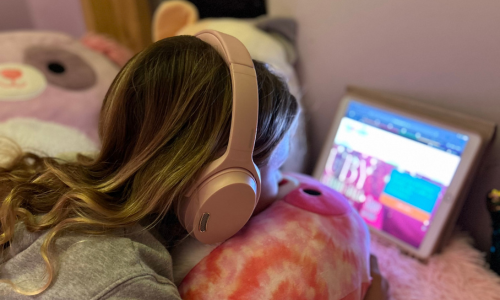
When hosting the celebration at home, engaging your kiddo in the planning process can significantly alleviate any anxiety they might feel about the event. Include them in planning the guest list, so that they know who will be there. Allow them to be a part of setting the menu, so they know there will be food that they enjoy. If they enjoy cooking, you can even encourage them to help you prepare the food.
Decorations, though essential, can overwhelm kids with ASD or SPD. Empower your child to select and hang streamers and balloons, ensuring a comfortable atmosphere. If they love arts & crafts, consider letting them make their own ball for the ball drop out of balloons, foam, play doh, cardboard, or even paper mâché. When the moment comes, drop this ball from a deck or simply throw it up into the air.
Plan a Fun Family Night In
Create a cozy fort in the living room using old bedding, comfortable pillows, and blankets and enjoy a family movie in the fort. Consider using a weighted blanket to reduce anxiety, especially if your neighborhood gets loud during New Year’s Eve celebrations.
If your family enjoys board games or puzzles, plan a night of bonding and fun around the table. This relaxed setting allows for quality family time without the sensory challenges of larger gatherings.
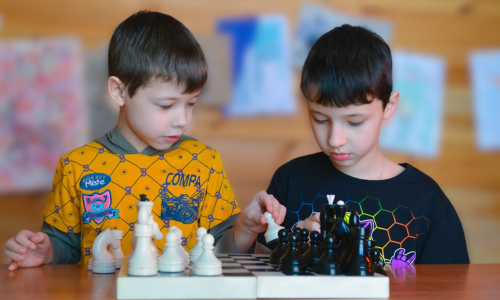
Encourage your child to create a memory book of their favorite moments from the past year. This can be a creative project, incorporating drawings, colors, or even a written story. The best part? You can keep this as a keepsake to revisit every year.
Help your children write down their New Year’s resolutions. If they love arts & crafts, supervise them while they cut up old magazines or help them print out pictures from the internet for a vision board of their goals that can be hung in their room for inspiration in the upcoming year.
Keep Your Plans Flexible
Remember, flexibility is key. Be prepared to adapt plans or even leave an event early if needed. Additionally, consider using a soothing sound machine for light sleepers to ease bedtime, especially if fireworks are expected in your neighborhood. With careful planning, you can create a New Year’s Eve that is enjoyable for your child and the entire family.
If you are interested in learning more about how Schreiber’s Pediatric Behavioral Health Services and Occupational Therapy Services can help your child visit http://www.schreiberpediatric.org/behavioral-health/
As a nationally recognized pediatric facility, the Schreiber Center for Pediatric Development provides family-centered education and therapy programs for infants, children and adolescents with disabilities, developmental delays, and acquired injuries. Our goal-oriented approach maximizes each child’s ability to function independently within the community.
Kolton Conquers Sensory Struggles and Graduates Occupational Therapy Victorious
December 18, 2023At three years old, Kolton was having difficulty within a variety of areas including attention, transitions, emotional regulation, sensory processing, using feeding utensils, and pencil grip. His mom Sam, a behavioral consultant who had a professional history with the Schreiber Center for Pediatric Development, brought him to the center for assessment. “I wanted to be sure that if there was something more we could be doing to help him struggle less, we were doing it.” Sam shares.
During his assessment, it was discovered that Kolton’s visual motor skills were in the average range. However, his fine motor skills were below average impacting his pencil and feeding utensils grasp. He was also demonstrating sensory processing differences, with a mixture of both sensory seeking and sensory sensitivity resulting in deficits in body awareness, impulse control, auditory sensitivities, and oral sensory seeking actions. Because of this, it was recommended that he begin occupational therapy sessions with Bianca to work on improving these skills.
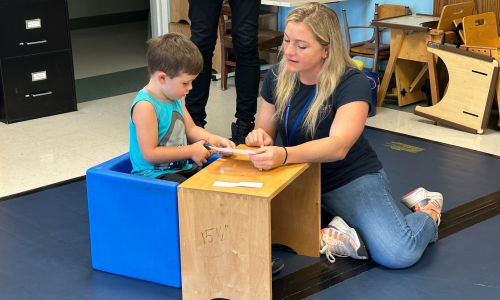
During OT treatment, it was determined that Kolton had retained reflexes requiring reflex integration therapy. Reflex integration is the process through which primitive reflexes that are present in infants gradually diminish and are replaced by more controlled, purposeful movements as a child’s central nervous system matures. Kolton’s retained reflexes impacted his body awareness, bilateral coordination, fine motor, and his hand-eye coordination.
When Kolton began therapy, he had a very strong ‘infantile’ grip on writing and drawing utensils, and while he could write his own name, he had almost no interest in writing or doing any sort of arts and crafts. Bianca began working with him right away on learning how to hold his markers and crayons in a tripod hold with the correct amount of pressure when tracing images and coloring in between the lines. “It was especially helpful that Bianca played to his interests of trucks, trains, and other vehicles when coming up with new therapy games and crafts to do because it kept him engaged and made him want to do the work.” says mom, Sam. Now Kolton is a pro at the tripod hold and loves showing off what he works on in preschool every day. He doesn’t even mind practicing his fine motor skills at home anymore. Kolton also generalized his fine motor skill development to holding/using feeding utensils like a fork and spoon with an appropriate grip to self-feed during mealtimes. Kolton competed against Bianca picking up cheerios with a fork in sessions to improve this skill.

During their therapy sessions, Bianca noticed that Kolton was seeking heavy work and movement to help him process his sensory integration and began working those techniques into his therapy plan. To work on his hand-eye coordination skills and improve his bilateral coordination, Bianca worked with Kolton on midline crossing activities such as jumping jacks and cross crawls. These exercises helped Kolton learn how to move both sides of his body at the same time and allowed him to practice those skills while getting to move around. Since these activities don’t require any additional equipment, they were also perfect to practice with his parents at home.
Kolton also took his sensory work home with him to practice, and mom Sam proudly shared that he has improved with sitting still so well that “We recently took Kolton to his first movie in the theater, and he was able to stay in the theater without getting up and moving around for the entire movie.” She explained that he had never even done that at home; so for his first successful movie experience to have been in a theater was especially thrilling. Not only that, but the struggle over his daily routines has greatly diminished, and he has even recently started to brush his teeth on his own. Sam attributes these successes to the sensory work he’s been doing in OT with Bianca.
According to Sam, one of the biggest benefits to Kolton’s therapy journey at the Schreiber Center though is that he is slowly moving towards more independence. She shares her pride in the fact that he has even learned how to be an advocate for himself and tell those around him when he needs help, and even more importantly how they can best help him. His mom attributes this to the absolute perfect fit that Bianca was for him. Looking back, she remembered that he used to be a shy kid, hiding behind her until he was comfortable, but he took to Bianca almost instantly and by his second session wasn’t even turning back to wave bye to her as he walked into the OT gym. “This self-confidence has spilled over to preschool where he now goes three times a week with no struggle” mom boasts.

At Kolton’s October assessment session to determine if he would require additional therapy, Bianca told mom “We’re still working on strengthening midline crossing, but he’s succeeded in all his other goals. We’re recommending one more care of treatment plan for an additional 13 weeks, but he will likely be ready to graduate in 6.” Now just nine months after beginning OT services with Bianca, Kolton has graduated. Watching him get his handprint on our walls at graduation was a bittersweet moment for everyone involved. Of course, we want all our kiddos to improve to the point that therapy is no longer needed, but we always miss them and hope that they’ll come back to visit even after their last appointment is complete.
Reflecting on Kolton’s therapy journey, Sam shares something that got her through the tough times was remembering that nothing gets better without putting in the work. Pediatric therapy is a journey filled with ups and downs, but the kids and parents who put in the work agree, the payoff is immense. Sam recommends to all parents who are thinking about pediatric therapies for their children “Do it! It is better to do the assessment and know for sure whether your child needs the extra help that pediatric therapy can provide to them, than to not know and wonder if there is something else you could be doing to help them. There is no need to struggle though when the assessment is simple, and the process of therapy at Schreiber is so fantastic. There is no shame in asking for and accepting help.”
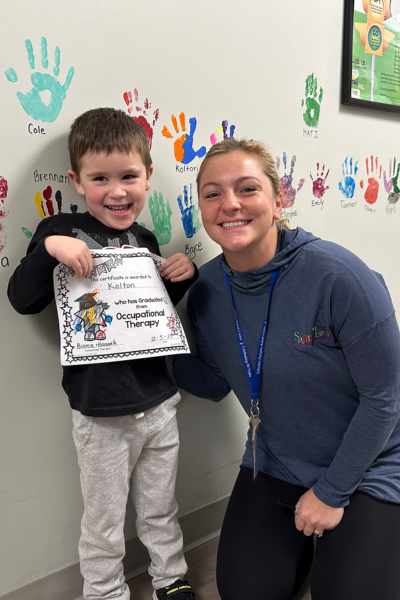
Help Schreiber Clients like Kolton receive the care they need, consider donating in support of our Kids’ Care Fund, a long and short term savings account used to cover the costs of uncompensated care.
As a nationally recognized pediatric facility, the Schreiber Center for Pediatric Development provides family-centered education and therapy programs for infants, children and adolescents with disabilities, developmental delays, and acquired injuries. Our goal-oriented approach maximizes each child’s ability to function independently within the community.
Brookfield’s Safe Harbor Team Steps Up for Schreiber Center
November 20, 2023Brookfield Renewables hosted their company-wide step competition, a fantastic initiative promoting healthy exercise habits while raising funds for charity again this summer and a team from Safe Harbor Dam right here in Lancaster, PA won second place! What makes this announcement even more special is that they’ve chosen the Schreiber Center for Pediatric Development as the lucky recipient of their hard-earned winnings totaling $2,500!
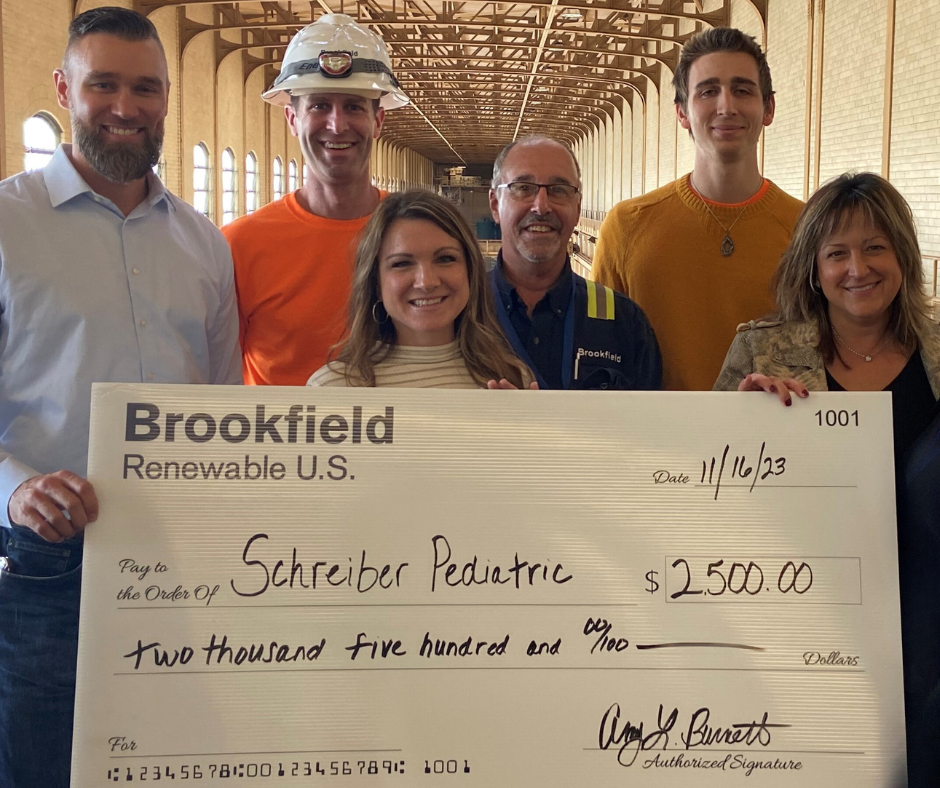
We want to extend our deepest thanks to the incredible individuals who made this possible, the champions of wellness from the winning Safe Harbor Dam team. A special shout-out goes to Dustin Droege, Keith Heisey, Mike Denlinger, Max Minnick, Alicia Blankenmeyer, Jon Kuzma, Tyler Reifsnyder, Brittney Orwick, and Dylan Steinfelt. Your dedication to getting those steps in were instrumental in securing the funds that will directly impact the lives of the children we serve.
Dustin, Keith, Mike, Max, Alicia, Jon, Tyler, Brittney, and Dylan, your efforts have not gone unnoticed. Each step you took in the competition was a step towards creating positive change for local children in need. Your enthusiasm for both wellness and philanthropy is inspiring, and we are profoundly grateful for your role in helping us provide therapy services to even more Central Pa kids. Your generosity is a beacon of hope for the children and families we support, and we’re honored to have you as partners in our mission.
We’re already looking forward to cheering you on in next year’s competition! The prospect of being selected once more as the beneficiary of the funds raised in the 2024 company-wide competition is truly an honor we’d cherish. Your continued support touches our hearts and helps create an even brighter future for the children we’re privileged to serve.
Donate today to join Safe Harbor in helping Schreiber clients continue to receive the care they need.
As a nationally recognized pediatric facility, the Schreiber Center for Pediatric Development provides family-centered education and therapy programs for infants, children and adolescents with disabilities, developmental delays, and acquired injuries. Our goal-oriented approach maximizes each child’s ability to function independently within the community.